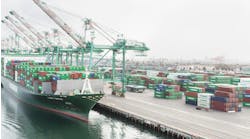What you’ll learn:
- How companies use 3D printing to improve their supply chains
- Why 3D printing is disrupting traditional supply chains
Thanks to 3D printing supply chain applications, decision-makers have explored new, faster ways to source components, create prototypes and more. What have they accomplished, and why should others strongly consider following their lead?
Producing Large Parts Faster During Challenging Times
Recent global conflicts have revealed how unreliable the world’s supply chains can become under particular conditions. Situations become more complicated when the products companies need are oversized components primarily produced overseas. Then, those purchasing the items must handle the daunting task of getting those large goods across state and country borders.
However, research from the Department of Energy’s Oak Ridge National Laboratory showed how to apply 3D printing supply chain alternatives to these challenges. Participants explained the increasing difficulties in getting low-volume castings or forgings for components weighing 100-200 pounds from domestic suppliers. Enterprises needing those products must order them from abroad and handle all the potential obstacles accompanying that option.
The project focused on using 3D printers to create rotating steam turbine blades for generating energy in power plants. Researchers initially worked on applying the technology to repair the components. However, when the COVID-19 pandemic hit, people faced wait times of at least a year for these parts. Then, the group broadened its scope to work on producing entire replacement components rather than repairing faulty ones.
This approach eventually allowed the production of the blades in two weeks, including the required machining steps to finish them. Even as recently as late 2023, lead times for these conventionally sourced components were still as long as nine months, showing the worth of exploring new ways to get them.
The researchers also explained that this production approach gives manufacturers more freedom to include customized parts in their supply chains. For example, it prevents them from relying on a single mold from a specific casting house when replacing a component. Additionally, 3D printing tackles obstacles associated with swapping out parts that are no longer produced regularly because the relevant equipment is several decades old.
Creating a 3D Printing Supply Chain for Those without Equipment
Some supply chain professionals may be curious about how 3D printing could improve their operations but not ready to purchase the necessary equipment. Similarly, others lack the physical space or trained personnel to implement the technology, making them understandably cautious to make the leap.
However, an Australia-based 3D printing business offers a containerized, plug-and-play solution that allows customers to make parts from metal. It includes the printer, compressor and dust extractor in a single booth that is easier to transport than the former method of shipping the printer separately from the other components. Extraordinary efficiency is another selling point, with the machine working 1,000 times faster than competing options can.
This option's remarkable speed and convenient portability make it especially disruptive. Users can manufacture critical parts in hours, eliminating the need to wait weeks or months for them to arrive from worldwide supply chain partners.
This brand’s approach to printing is also ideal for military clients or others who spend weeks or months in remote or dangerous locations. When the printer comes directly to a customer, they can quickly print the desired quantity of items while eliminating the complications from working with multiple distributed supply chain partners.
Meeting Customized and Personalized Needs with Micro Products
The 3D printing supply chain also suits those needing products that meet precise requirements not necessarily fulfilled by off-the-shelf items. For example, micro parts are less than 10 millimeters, and clients may need them in small batches. Numerous efforts are underway to curb counterfeit products. Adding a tiny, individualized identifier to in-demand products with printers could offer customers ways to differentiate between genuine and fake goods.
Organizations are also developing microscale products for health care applications. An ongoing five-year project with multiple participating universities is testing some of them. Those involved are identifying, selecting and processing potential materials and methods used to make 3D-printed items for the medical industry. In the best-case scenarios, patients could get pieces made just for them, resulting in better outcomes.
One possibility explored in this study is a personalized, 3D-printed pill that could replace conventional vaccines and all the associated supply chain challenges. The team envisions scenarios where patients would receive pills by mail and take them as they would vitamins or over-the-counter painkillers. Such options would eliminate the need for vaccination supplies and the labor force to administer the injections.
The researchers are also examining the possibility of a micro-printing method that creates an intestinal patch that goes inside a patient’s body to regenerate inflamed tissue. The smaller a 3D-printed component, the more potential opportunities it has for meeting hard-to-address needs. Although it could be a while before such options become mainstream, the ongoing work to develop them is undoubtedly fascinating.
Taking Made-to-Order Products to the Next Level
Demand volatility is a significant and enduring supply chain problem due to its inherent unpredictability. Leaders try to mitigate the effects by predicting trends, but reality does not always follow expected patterns. Sometimes, the best solution is moving away from mass-produced goods toward those made for individuals.
Imagine if a football player’s helmet had inserts shaped to match their precise head shape. 3D printers can create them. Customization is an emerging trend in some professional sports applications, with users saying the results are much safer than standardized possibilities.
Eyewear, bike saddles and dresses are some of the other products 3D printers can make to suit individual users. Another example comes from a vitamin company that makes gummy supplements containing the nutrients each customer needs. People begin the process by taking a two-minute questionnaire. The answers determine which seven of 35 possible nutrients their vitamins should contain. They can then choose from several flavor-coating options that change the supplement’s taste.
Once someone finalizes an order, 3D printing occurs when seven plastic-free, food-grade syringes rotate to encapsulate the active ingredients and prevent any destructive interactions between them during production. Those familiar with the process say on-demand printing and quick shipping speeds keep the gummies in optimal condition before, during and after their journeys to customers.
Offerings such as these counteract supply chain volatility by allowing companies to create goods once customers have indicated they will buy them. This 3D-printing supply chain benefit can help businesses operate more effectively with substantially less waste and unsold goods. Additionally, purchasers appreciate the customization that allows them to have one-of-a-kind products at more affordable prices than they likely imagined.
Succeeding with the 3D Printing Supply Chain
These compelling examples show why supply chain professionals have many compelling reasons to add 3D printing to their strategies. Today’s world poses numerous challenges that complicate receiving, ordering and shipping goods. However, people can overcome them by using disruptive technologies and processes.









